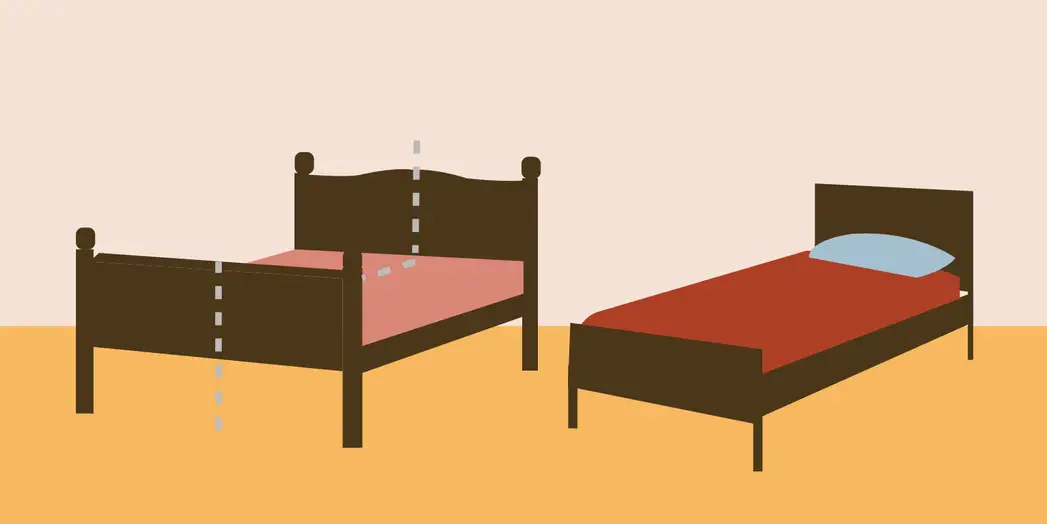The bed must always be a beautiful place, not only because you make love there but because you dream there as well.
Anaïs Nin
Why buy the best bed?
Let’s face it, your bed is a big part of your life. It always has been and always will be.
It might not always be the same bed but wherever you are, at whatever time in your life, the nearest bed isn’t too far away.
Most of us:
- were conceived in a bed
- were born in a bed
- will spend approximately 25 years of our life in a bed
- will consummate our marriage in a bed
- will conceive our own children in a bed
- will die peacefully in a bed (hopefully).
Beds are our bedrock from birth to death. And that’s why finding the right bed is almost as important as finding the right partner, the right job or the right house.
Bed time is time well spent
If you live until the age of 70 then you’ll spend, on average, 220,000 hours asleep. You’ll probably do this in a bed.
During your lifetime, you’ll spend more time in bed than you will in any other single location! So it makes sense to find the right bed for you.
It’s important to take into consideration your weight, height, body shape and medical status. And there are no shortcuts when it comes to buying a bed.
You need to invest time and money in one of the most important purchases you’ll ever make.
You wouldn’t buy a sofa without sitting on it first. You wouldn’t buy a car without getting behind the wheel, so don’t buy a mattress unless you’re 100% sure it’s for you.
When should you buy a new bed?
Regardless of what bed manufacturers or retailers tell you about how long a bed should last (some say eight years and others say 10) you only really need to consider buying a new bed when you start to notice negative changes.
Consider buying a new bed if:
- you wake up stiff, numb or with aches and pains
- you don’t sleep as well as you did
- your mattress feels uncomfortable
- your mattress creaks when you move
- you and your bed partner roll towards the middle of the bed.
Some manufacturers and retailers are now offering 25-year guarantees on their mattresses but that’s no surprise. What can go wrong with a lump of foam?
However, it’s worth remembering that every night you sweat out a significant amount of moisture and shed a good amount of dead skin into your mattress. So, for hygiene reasons alone, it’s a good idea to change your bed from time to time!
Of course, buying a bed — even if it’s the most luxurious or most expensive bed on the planet — won’t guarantee you a good night’s sleep. That’s rather like a bad driver buying an Aston Martin and expecting to become a better driver overnight.
Finally, if your lifestyle or bedroom environment isn’t conducive to good sleep then having a good bed will make little difference. You can read more about creating the perfect bedroom environment here.

What kind of mattress should I buy?
Science cannot measure comfort. Essentially, bed comfort is a matter of personal choice.
It’s impossible to judge the comfort of a bed by its price, its fillings or its tension. There’s never been a ‘one bed fits all’ solution.
Mattresses differ in comfort and support so, historically, manufacturers and retailers have emphasised that the only way to choose one that’s right for you is to go out and lie on as many beds as possible.
It’s sound advice.
However, mattress manufacturers don’t make it easy for you to make the right choice. That’s because there’s no scientific measure of mattress comfort.
Furthermore, the consumer is usually only presented with the following three choices:
- soft
- medium
- firm.
However, the meaning of each of these terms is rarely defined. One manufacturer’s ‘firm’ may be another’s ‘soft’!
You can’t easily compare one manufacturer’s mattress with another without lying on several beds in different showrooms. But how do you remember how one bed felt a week ago in another town compared with the one you’re trying out now?
Soft sell, medium risk or a firm deal: the mattress minefield
There’s simply no way of knowing if one manufacturer’s cheap ‘firm’ bed is actually softer than their more expensive ‘soft’ bed.
Each mattress will feel different. A ‘medium’ mattress made with pocket springs and natural fibres will feel very different from a mattress made of foam.
But do you understand the real-world difference?
The terms refer to the support that the bed provides but they don’t denote comfort. For instance, with a sprung bed, the firmness is a description of the springiness of the springs. That doesn’t mean that there can’t also be a comfortable level of filling above the springs. A firm bed doesn’t have to resemble sleeping on the floor.
This is important when considering buying a bed if you have back pain — it’s been proven that the old wives’ tale of needing a firm bed will actually make sleep worse for those with back pain.1
What you really need if you have a bad back is a softer mattress. You’re not necessarily looking for a soft mattress but a mattress that is soft in relation to your bodyweight.
For example, if you weigh:
- up to 70kg then you’re probably best sleeping on a soft mattress
- between 70kg and 100kg then a medium mattress might be best
- more than 100kg then consider a firm mattress.
But remember we’re all different and beds are different. That’s why lying on a bed is always the best barometer when considering comfort.
How to choose a mattress
The key to buying a mattress lies in the line of your spine.
If a mattress is right for you then your spine:
- should be straight when you lie on your side
- maintain a natural curve when you lie on your back.
Make sure that you’re sleeping ‘in’ the bed and not ‘on’ the bed. If your mattress is too hard then it stops both the hips and shoulders from sinking down. If your mattress is too soft then it’s unable to provide any resistance to your body’s weight.
So when you’re looking for the perfect mattress make sure:
- it feels instantly comfortable
- you lie on it for at least 10 minutes
- you try as many sleeping positions as possible.
It might feel a little laborious and even slightly embarrassing to spend so much time lounging around on brand new beds in public. But if you find the right bed then it really is worth it.
‘Sleeper’ sells
Are you a ‘side sleeper’ or a ‘back sleeper’? Or maybe you sleep face down?
In truth, you probably do all three and more at some point during the night.
There are mattresses and pillows pitched at side sleepers, back sleepers and every sleeper in between but they’re simply reflecting a demand rather than any hard evidence that different sleepers need different mattresses and pillows.
Research shows that you naturally move 40-60 times each night. In that time you’ll experience 10-20 major positional changes.
Changes in position during the night aren’t an indication of disturbed sleep, but reflect your body naturally relieving pressure and regulating temperature.
So there’s really no point paying over the odds for a mattress that claims to benefit a back sleeper — when you’ll inevitably be on the move.
In addition, 30% of people incorrectly report their body position when the lights go out so you may not be the sleeper you think you are!2
Buying your mattress: on a roll
It’s important to feel what your mattress is like when you try to roll over. It’ll take a lot of effort if the bed’s too soft and will feel uncomfortable on your hips and shoulders if it’s too firm.
Try testing the bed by lying on your back and placing your hand between your back and the mattress.
If this is easy and it feels as if your hand’s in a space, then the mattress is too hard. You’ll also be able to determine if a mattress is too firm through increased pressure on your shoulders and pelvis.
If, on the other hand, you can hardly get your hand into the same space — or only with great difficulty — then the bed’s too soft. At this point you may also feel the body ‘drooping’ a little and forming a gentle curve.
If you haven’t found the right fit for you, try the same model of bed with a different firmness and keep testing.

The mattress test really matters
Most people test a bed by sitting on the corner of the mattress, bouncing up and down and saying ‘it’s a bit soft’.
But think about it. You’re putting your entire weight on a small area of the bed via your buttocks and the springs were never designed to deal with this targeted pressure time after time.
So don’t simply bounce before you buy.
Those brave enough to try out a bed in public tend to lie flat on their backs as if they’ve been lowered into a coffin. But, unless you’re a vampire, nobody sleeps completely still with their arms down by their sides and it’s no way to test the comfort and compatibility of your next bed.
Test the mattress as if you’re at home in bed… although there are limits! Just wear comfortable clothes and roll with it.

Don’t use your eyes when buying a bed
People tend to buy a bed with their eyes rather than with their body.
They’re seduced by a stylish bedstead or a fancy headboard rather than understanding that looks aren’t everything in the bedroom.
However beautiful a bed looks it’s the feel of the mattress, when you’re lying down, that’s of the utmost importance.
The ‘technical specifications’ are no indicator of overall comfort. More springs don’t necessarily mean it’s a more comfortable option.
The price of the bed also has no bearing on how it feels for you. More expensive doesn’t necessarily mean a more comfortable sleep.
Don’t be seduced by ‘technology’
As we’ve already mentioned, science is unable to define or measure ‘comfort’ and technology can’t tell you if a bed is comfortable.
A pressure map of you lying on your back will be very different to a map of you lying on your side.
And where should you lie in your brand new bed?
Many companies offer mattresses with numerous body zones. But unless they modelled it on your body is it really going to guarantee a comfortable sleep?
Within the length of a standard mattress it’s impossible to position the body zones so that they align with both a 5ft 2in female and a 6ft 4in male.
In addition, there are numerous ‘scientifically’ designed fibres that are billed as being able to revolutionise your sleep. ‘Memory’ foam was developed by NASA in the 1960s but being comfortable in space is very different to being comfortable back home on earth.
In truth there’s nothing revolutionary or scientific about them. Just think about it. Nylon and polyester were touted as ‘scientific’ fibres back in the day!
Size really does matter if you’re sharing a bed
A standard UK double bed is 4ft 6in wide which means you and your bed partner each have 2ft 3in of space in which to sleep. The single bed, that you may have slept in as a child, is either 2ft 6in or 3ft wide.
Whichever way you look at it you’ve got either 3in or 9in less space to sleep than you did as a child! The numbers just don’t add up.

Children usually share their bed with a few cuddly teddy bears that stay put all night. However, you might share your bed with a kicking, punching, snoring, duvet hugger that also happens to take up a lot of space. No wonder you’re not sleeping well!
So when it comes to buying a bed, if you share your bed with someone else ― go big… or go home.
Money, Money, Money
Given the value of a good sleep to your mental and physical health, it’s amazing how little we set aside in the pursuit of sleep happiness.
The equivalent of £1 per night spread over 10 years equates to £3,650. And with that budget you could get a lot of bed for your buck.
We’re aware that most people just won’t have that type of money to fork out on a bed. However, a study revealed that 8% of the UK population spent less than £100 their bed, arguably on one of the most important purchases they could possibly make.
When you’re thinking about how much money you might need to set aside for a good bed, compare what other less important things that you might be willing to spend money on e.g. a daily latte or an expensive mobile phone contract. Compare the cost of those things over the next decade to what you’re willing to invest in your sleep.
Remember the pillow
The mattress provides comfort and support for your body, but it’s the pillow that does the same for your head and neck.
You need a pillow that works in tandem with the mattress in order to align your body for the perfect sleep. Look for a pillow with the right height and filling and remember to keep your head and neck at the correct angle.
It’s another case of try before you buy. Purchasing the wrong pillow can be a real headache.
And don’t forget the duvet
If you’ve gone through all of the trouble of choosing the right bed and pillows then don’t forget the duvet.
One of the most important factors the contributes to a great night’s sleep is your ability to lose body heat during the night. Most of the heat is lost from our face and head, as that’s the bit that sticks out from under the duvet.
But having too warm or too cool a duvet will affect this temperature loss and make getting great sleep more difficult.
Thankfully, duvets have a standard warmth rating so, for example, you can be sure that all Tog 13 duvets provide the same degree of warmth whatever the filling.
Consider your own sleeping environment and choose the duvet you need rather than the duvet the manufacturers want you to buy.
Got the perfect bed and still can’t sleep?
You’re not alone. Unfortunately, sleep issues usually get worse the longer you leave them. So, if sleep has been a problem for you for some time, then it’s time to do something about it. Just like bed comfort, sleep is personal. Your sleep needs are as individual as you are. That’s why our sleep support program is tailored just for you.
We can help you understand what’s going wrong with your sleep and give you the tools and guidance you need to fix it. Through your online account, you’ll have access to advice from leading sleep experts.
Trust us to guide the way and, within a few short weeks, insomnia could be a thing of the past for you. We’ll show you how to apply the science, taking into account your personal needs and circumstances, to get the best sleep possible. We’ve helped many thousands of people from all over the world to sleep better. Could you be the next person we help?
Are you worried about your sleep?
We can work with you to find the root cause of your sleep problems and help you to improve your sleep.
Summary
- One size fits all isn’t true for beds.
- Comfort in beds and mattresses is down to individual preference.
- Orthopaedic or really firm mattress are not necessarily the answer if you have a bad back.
- Try before you buy.
- Size does matter.
- Looks aren’t everything.
- Expensive doesn’t always mean best.